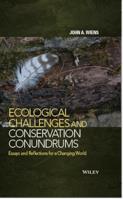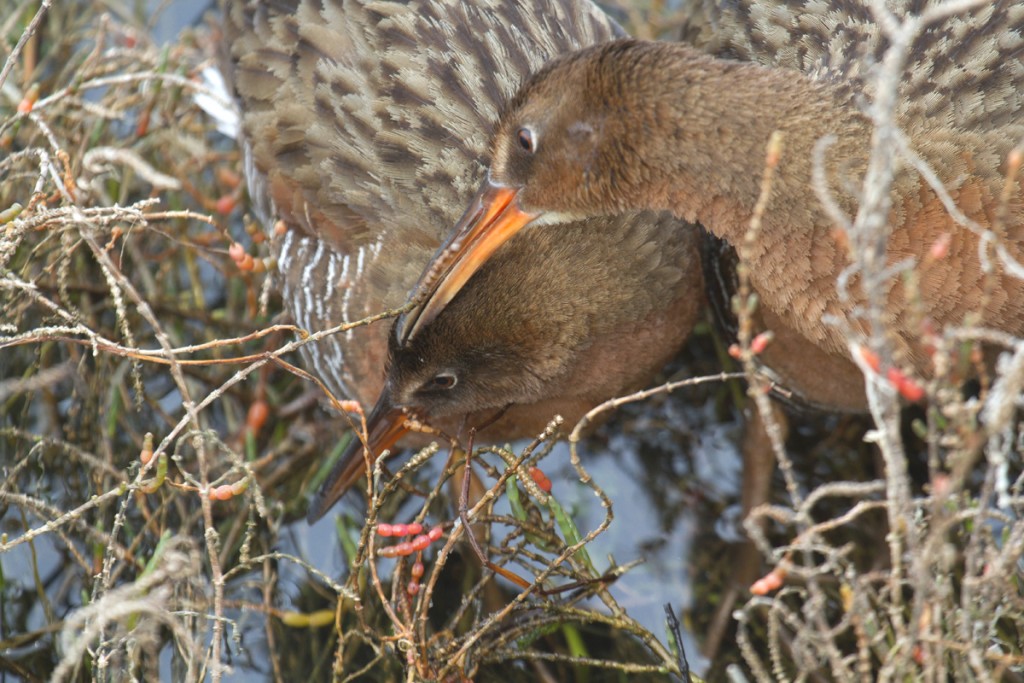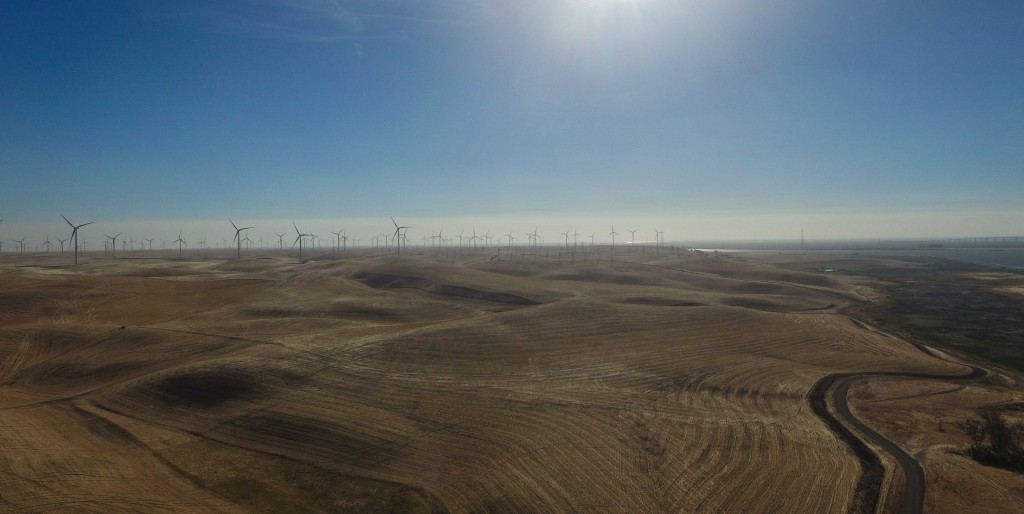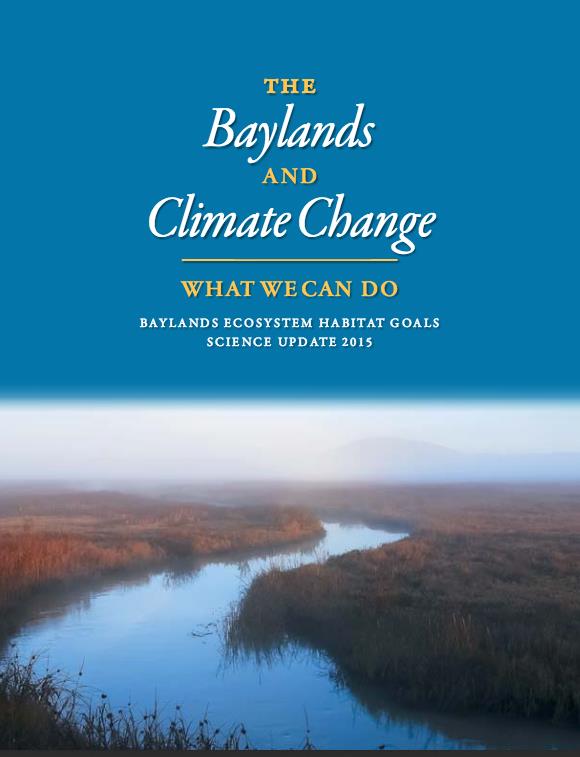By Ariel Rubissow Okamoto
Whatever the “perturbation” coming our way – a flood, a drought, a weed or Donald Trump – our recovery, in the aftermath, depends on something ecologists call resilience. It’s a term everyone is pasting onto their management initiatives these days – resilient landscapes, resilient shorelines, resilient water supplies, neighborhoods, infrastructure… But what exactly does it mean, and how is it different from other fashionable buzzwords that have galvanized Californians into thinking about the future?
“It’s not a replacement for the still very valid goals of ‘restoration’ and ‘ecosystem health,’” says Marilyn Latta of the State Coastal Conservancy’s Living Shorelines Project. “It’s is about [visualizing] those concepts through the lens of climate change.” From this perspective, she says, resilient refers to natural habitats being as strong and robust as possible (in terms of ecosystem structure, functions, and services) as soon as possible in order to best withstand stressors such as changing temperatures, freshwater regimes, and sea level rise over the long term.

“Like adaptive management, it’s become somewhat of a holy grail: manage systems for resilience and they’ll be able to absorb all the stresses we throw their way,” adds John Wiens, a member of the Delta Stewardship Council’s Independent Science Board. “What’s not obvious is how one should go about enhancing the resilience of a system, except perhaps by fostering diversity or not putting all one’s eggs in one basket. Sounds good, but the devil is in the details.”
Even after half a dozen interviews and numerous papers explored to write this story, the details on the actual characteristics of resilience are still fuzzy. The fuzziness is both a strength (in terms of universal appeal and application to everything from hedge funds to emergency preparedness) and a weakness (in terms of the lack of a way to measure it scientifically, not to mention some ambiguity about the desirability of any status quo we are trying to make resilient, such as the current Delta).
Officially, definitions of resiliency range from the social — the capacity of individuals, communities and systems to survive, adapt and grow in the face of stress or shocks – to the ecological — the amount of disturbance an ecosystem can withstand without changing self-organized processes and structures.
Unofficially, it’s touched on by this water conservation fable from the US Geological Survey’s Jim Cloern: “Trying to be a good citizen, I replaced my back lawn with artificial turf. After it was installed, the blades stood tall and from a distance kind of looked like grass. After a year of my lab racing across the plastic grass the blades are bent over, matted down, and I don’t know how to get them to stand upright again. Artificial turf is not resilient because it doesn’t return to its original state after a perturbation (her name is Bella).”

“The whole notion that a system can bend but not break is comforting,” says Wiens. In a new book called Ecological Challenges and Conservation Conundrums, out this April, he uses real grass in bigger patches than Cloern’s backyard as an example: “A grassland that is moderately grazed may change in some details of species composition and nutrient cycling, but if grazing is stopped it can return, in time, to something approximating its basic function and structure … Grazed too heavily, however, the system may be so degraded that it cannot recover—a threshold has been passed and the system moves to an alternative state, such as a shrubland or barren desert. Its resilience has been exhausted.”
“If you think about resilience as how well systems can absorb and recover from impacts, you can actually use that criteria across all kinds of sectors,” says Maggie Wenger, a climate planner with the San Francisco Bay Conservation and Development Commission’s Adapting to Rising Tides Project. “Whether I’m thinking about a marsh or a park or a human community or a highway, resilience is a [useful planning] bar.”
Last year a San Francisco Estuary Institute team led by Erin Beller made what is widely viewed as the first successful attempt to defuzz resilience in a project funded by Google. They convened a strong national science panel to vet the working definitions and applied the tenets to a watershed-wide vision of ecological resilience in relation to infrastructure and land use in the South Bay, according to coastal ecologist Peter Baye.
The resulting 2015 Landscape Resilience Framework, which was then applied in a Silicon Valley Vision, revolves around seven specific elements. Asked how Google might consider it’s application, or what this means for the built part of Silicon Valley and the people who own it, the company’s Audrey Davenport had this to say: “A couple years ago, our real estate team realized we needed the guidance of the region’s best resilience scientists in order to develop a roadmap for our physical presence in the Bay Area. Today, the work emerging from the Resilient Silicon Valley project is providing just that. The Framework and Vision lay out for us what is most important for long term ecological health — restoring riparian corridors, replanting native vegetation, like oaks and willows, and planning at regional scale, rather than a site scale. We consider ourselves a customer of this emerging science, and share it with all of our real estate teams and landscape architects. We hope other planners and land owners in Silicon Valley will find similar value and we look forward to partnering with them and demonstrating implementation of the Vision on our Mountain View campus as one of our strategies for addressing the impacts of climate change in California.”
Coping with Change
Resilience is clearly about coping with change, whether it’s social, ecological, political or physical. Any evaluation of this coping ability seems to begin with two questions: resilience of what (a river, a bird, a city, democracy?) to what (hotter days, rising seas, crime, pollution, invasive species, super PACs?).
In the Estuary system, the “of what, to what” runs the gambit from the resilience of tidal marshes to rising seas (or how long will they last till they drown?) to the resilience of native fish to non-natives who want to eat them and eat their food. “The real problem is not just that fish are declining and that there’s something wrong with the food web, it’s that we’ve lost the flow and flooding processes that make a resilient ecosystem that can handle human-caused stresses,” says Bay ecologist Letitia Grenier of the San Francisco Estuary Institute. “To have resilience you have to have viable physical and ecological processes.”
Water itself, a fluid thing, may be key to the processes that speed recovery and enhance resilience. Indeed from some perspectives aquatic habitats might be more resilient than terrestrial ones. Clifford Dahm, lead scientist for the Delta Science Program, saw it for himself after volcanic perturbation. “When Mt. St. Helens erupted, many of the aquatic systems that were extremely altered by the eruption came back within a decade. Streams and lakes proved highly resilient, but that’s partly because aquatic organisms have shorter lifespans. Getting a coniferous forest or oak savanna back would take much longer.”

Size also matters for resilience, as we learned from the 2015 State of the Estuary Report’s evaluation of marsh patches. You have to have big enough patches of remaining habitats, linked by wide enough migration routes, for wild things to withstand disturbance. When scientists recommended restoring 100,000 acres of tidal marshes around the Bay, in large enough patches to have more complex channels and drainage systems, they were thinking about earlier concepts like resilience. They knew that certain species only thrive if their habitats are big enough.
When humans are around, bigger also provides more room for mistakes like open sewer valves at the end of a broken tank drain that create perturbations like the 1988 Shell Oil spill onto Martinez marshes. Indeed, any system needs a back up to be resilient. If one habitat gets oiled, or if one bridge falls in an earthquake, there should be alternates. That’s why redundancy and diversity — like scale, connectivity and viable processes – are other important elements of resilience. Don’t plant just one kind of shrub, plant a whole range with different tolerance levels for heat stress. If one Internet server fails or gets hacked, make sure there’s a way around it.
Conversely, simplifying natural complexities can make systems less resilient. Areas where fringing vegetation, such as mangrove forests or marshes along a coast, has been cleared are much more vulnerable to storms and tsunamis. Areas where vegetation becomes intensely managed, such as in modern agriculture, are also less resilient, writes Wiens. “[Farmers] attempt to control sources of variation (“disturbance”) and remove threats [by applying] fertilizers or pesticides. In the process, natural resilience is sacrificed, replaced by engineered resistance… As new threats emerge, additional nutrient inputs or stronger pesticides may be needed, plunging the system into an arms race (e.g., pesticides versus pests) that further erodes resilience and increases the vulnerability of the system to unusual stresses or sudden environmental changes, such as a severe drought.”
Of course no one naturally anticipates unusual events and humans enjoy exerting controls based on an assumed continuum between past, present and future. This may be why our nation’s natural resources regulations embody a preservation paradigm aimed at saving individual species from extinction rather than bolstering the integrity of ecological systems. “The concept of resilience is being thrown like a blanket on top of existing legal mandates,“ writes Melinda Benson et al. in an interesting set of journal articles on resilience in natural resource management. “While managers might want to embrace resilience on a conceptual level, directives will inevitably default to core statutory and regulatory requirements,” she writes.
Most management structures are resistant to change, and unable to withstand change (they’re “pathologically resilient” themselves), argues Benson, hence the new focus from forward thinkers on adaptive management. Unfortunately, she writes, “The disconnect between adaptive management in practice and adaptive management in law is quite palpable.”
Lately the clamor for updates of our core environmental mandates, many of which were conceived in the 1970s in a time when we had to get a grip, via command and control, on rampant pollution and ravaged wildlife, has gotten louder. Resilience theory is helping to push the envelope, writes Benson. So is the fast-expanding Pacific.

At the State level, Governor Brown is leading the way with carbon emissions crack downs and an executive order directing State managers to give priority to soft, natural infrastructure, such as marshes, over hard walls in protecting themselves from coastal storm surges and sea level rise.
In the Delta, the mindset seems stuck on quick engineering fixes, which can hamstring future adaptability. It may be valiant to say the needs of fish are equal to the needs of people, when it comes to scarce water, but in practice neither species seems to be becoming more resilient as a result.
In the Bay Area, among the top ten metropolitan areas seriously threatened by sea level rise according to national studies, the hope is to mainstream resilience vision into capital improvements of aging infrastructure. In a time of rapid change with expensive consequences, managers are looking to those already engaged in updating flood control channels, highways, bridges, levees, dams, storm drains and wastewater treatment plants to incorporate resilience thinking.
“Ideally every time a city or county or flood control district has to do a big infrastructure update, they would think about ecosystem resilience at that moment, “ says Letitia Grenier. In this scenario, municipalities and water districts would have a vision in their pocket so they could see the opportunities to maintain a healthy environment, she says. So instead of just moving the road back from the shore to prevent flooding (a single benefit), for example, they might raise it up on a causeway so the tides could build a buffering marsh under it (purifying the water, protecting developed areas, supporting wildlife, and providing shoreline recreation, among many benefits). “We can’t expect government to fix all our problems and landscapes. It has to be government and us together,” says Grenier.
Resilience on the Ground
To get more specific, just how does resilience thinking help us face the two biggest perturbations on the Estuary horizon: drought and a projected rising sea level that calls for action now, before the rate of rise accelerates mid-century? Can, and are we, succeeding in applying resilience thinking on the water, shore and ground?
In the case of the Delta, one of the most altered and over-committed water systems in the world, three top scientists seemed skeptical about whether concepts of resilience even apply.
Clifford Dahm thinks parts of the Delta could be made quite resilient, though he prefers a passive rather than human-engineered restoration approach. Creating a “more natural functional flow regime,” rather than the highly altered existing flow hydrograph is one pathway he sees toward more resilience.
Sam Luoma thinks we might soon see the Delta cross a threshold into another state. “At the extreme ecosystems appear to flip into different stable states if their resilience is exceeded,” he says. In this new state, Delta managers would have rethink how they judge success or failure of any flow, habitat or species restoration efforts.
John Wiens thinks the current buzz about resilience is a distraction for the Delta: “If we think about resilience then we’re trying to maintain some semblance of a normal system, when in fact the reality is we ought to be managing for change and new extremes. Resilience thinking draws attention to the reality that there are limits to how much change a system can take before it becomes something else.”
The Delta is surely changing. Signs suggest several native fish species are virtually extinct, invasives are gaining ground, flows from Sierra snowmelt are no longer dependable, and that the drought is only making all these problems worse. “We’re starting to throw money at lost causes,” says Wiens. “It’s time to break out of our conventional mode of thinking that we can do everything if we just try hard enough. Even California doesn’t have the money to do that.”

Letitia Grenier, who directs the San Francisco Estuary Institute’s Resilient Landscapes program, thinks the challenge upstream is more about priorities: “The Delta is being asked to do too many things. You can’t have the same piece of land growing rice or corn also provide great habitat for fish. We have to be willing to give the Delta some water and some land if we want the ecosystem to be healthy. In the Bay, there was lower hanging fruit for acquiring that land, and the water came mainly from the ocean not snowmelt, so we had what we needed to start on resilience.”
Now that the easier stuff is done, at least in terms of restoring thousands of acres of wetland habitats around the bayshore, those working on Bay resilience may start to experience similar challenges to their counterparts in the Delta. “If we want to restore ecological processes, we have to go up into the watersheds, where a lot of land is privately owned, and work on how we manage streams and sediment and flooding,” says Grenier.
 Some good groundwork has already been laid. In the last five years, those building consensus and recommendations for the restoration of baylands, uplands and nearshore, subtidal habitats (like eelgrass beds and oyster reefs) carefully linked their work. In so doing, they also moved beyond the preservation paradigm, with its single species focus, and gained more resilience according to the Coastal Conservancy’s Marilyn Latta: “The 2015 update of the Baylands Goals recommends that we create much more diverse restoration designs that include a variety of topographies and vegetation types, and linkage between uplands and the offshore edge.”
Some good groundwork has already been laid. In the last five years, those building consensus and recommendations for the restoration of baylands, uplands and nearshore, subtidal habitats (like eelgrass beds and oyster reefs) carefully linked their work. In so doing, they also moved beyond the preservation paradigm, with its single species focus, and gained more resilience according to the Coastal Conservancy’s Marilyn Latta: “The 2015 update of the Baylands Goals recommends that we create much more diverse restoration designs that include a variety of topographies and vegetation types, and linkage between uplands and the offshore edge.”
Climate planner Maggie Wenger says BCDC’s been using the term “resilience” to engage cities, counties and shoreline landowners for more than five years. “People need to think about what options serve us now, and keep as many options open for the future as possible, instead of thinking ‘how high do I have to build the sea wall to protect everything just as it is, which is a losing proposition everywhere,” she says.
It’s hard for people in all sectors to agree to change the existing physical form of the shore, she says, whether it’s retreating from the coastal edge or filling the Bay with an innovative horizontal levee or rerouting a trail or wastewater discharge pipe, to name a few examples. “Resilience helps people think about a healthy functional shoreline that isn’t the shoreline we have now.”
One shoreline she and the Port of Oakland are dealing with now, in terms of planning for projected sea level rise, surrounds the Oakland International Airport. “The paradigm shift for me,” says Richard Sinkoff, director of the Port of Oakland’s environmental programs and planning division and Vice President of the Bay Planning Coalition, “is to see our port facilities, industries and the airport as the front line of defense from storm surge for the communities around us.”
“With so many of us invested in the shoreline, whether it’s Google over in the South Bay or the Port here in the East Bay or Caltrans with its highways around the Bay, we all want to address the problem without hurting the incredible asset to our businesses and quality of life that is San Francisco Bay,” he says. “So right now we’re all asking ourselves the same questions you’re asking about resilience, what does it mean to be nimble and to have the strength to bounce back?”
Sinkoff sees resilience as a logical extension of another buzz word, sustainability, and one that adds a slightly different spin. For him and other shoreline landowners, the idea of resilience came into focus after Katrina, Rita and Sandy showed everyone just how damaging super storms could be to the nation’s coastal communities and infrastructure. “Thinking about resilience asks us to figure out where are our vulnerabilities and where are our strengths, and then to develop strategies to bridge the gaps,” says Sinkoff.
One gap is the strength of the 1950s era perimeter levee around the Oakland airport; the Port is currently designing a significant upgrade to address flooding, seismic risk and sea level rise. Another is a stretch of Doolitte Drive along San Leandro Bay vulnerable to flooding,, according to Wenger. Her team is proposing that any major fix for this critical access route also include accommodations for a new segment of Bay Trail. “To have the trail next to road as proposed, you have to do fill, add riprap, and build a sea wall. We’d prefer to do that in conjunction with raising the elevation of the road, which gives us public access and flood protection at same time.” The combination could offer proving grounds for mainstreaming resilience into large infrastructure improvement projects.
Across the Bay, Silicon Valley’s landscapes may benefit from the new mindset provided by the Google-funded Landscape Resilience Framework. “Resilience is such a powerful concept, but it’s proven slippery to operationalize in real places. Our new framework provides a systematic structure for understanding what landscape resilience really looks like — and most importantly, how to actually apply resilience ideas on the ground,” says lead author and environmental scientist Erin Beller.
The products of Beller’s work can be found in two pithy and pretty publications that are welcoming to a non-science audience. Next steps include outreach to potential partners about how to keep resilience in mind while maintaining corporate campuses, parklands, and creek corridors.
![]() “If you look out the window in many places in the Bay Area, there’s still a lot of green. If you imagine everything that is out there was planted in a more purposeful way, thinking about ecological functions, there’s still a lot of opportunity even in really urbanized places,” says Grenier. “Even though our Silicon Valley Vision focuses on landscape resilience of particular ecosystem functions, like supporting wildlife, it’s heading toward applications for water supply, water quality, flood control, and more. We want our landscapes to be resilient in all these things.”
“If you look out the window in many places in the Bay Area, there’s still a lot of green. If you imagine everything that is out there was planted in a more purposeful way, thinking about ecological functions, there’s still a lot of opportunity even in really urbanized places,” says Grenier. “Even though our Silicon Valley Vision focuses on landscape resilience of particular ecosystem functions, like supporting wildlife, it’s heading toward applications for water supply, water quality, flood control, and more. We want our landscapes to be resilient in all these things.”
Many applications of resilience on the ground, in large scale restoration or redevelopment projects, have been funded by the San Francisco Estuary Partnership over the last few years. The Partnership will soon be producing a public information piece detailing lessons learned. Meanwhile, there’s no denying the power of the word to overcome the gloom and doom around climate change and rising sea levels. “Resilience is a positive framing,” says Wenger. “What we can’t and shouldn’t do is only talk about all the things we’re going to lose. It doesn’t lead us to action.”
Of course both action and resilience have homegrown appeal, says Grenier: “It’s how we identify ourselves as Americans. We can pick ourselves up and brush ourselves off.”
And perhaps even trump planetary perturbation. ARO
BCDC ART Project http://www.adaptingtorisingtides.org/
Landscape Reslience Framework: http://resilientsv.sfei.org/content/resilience-framework
NEXT STORY: Bay Belle